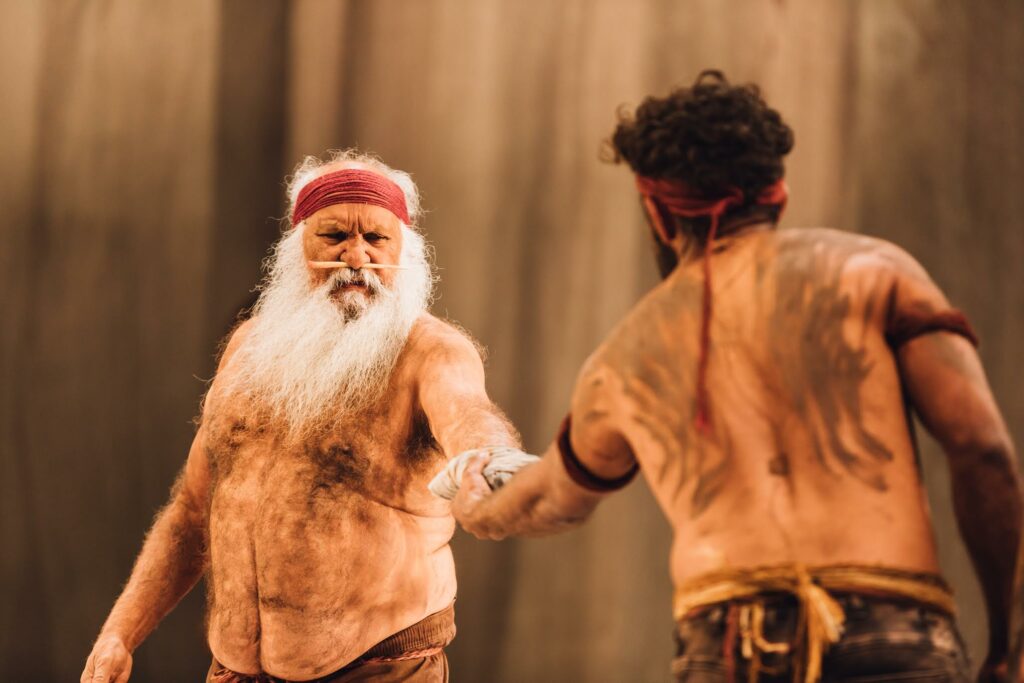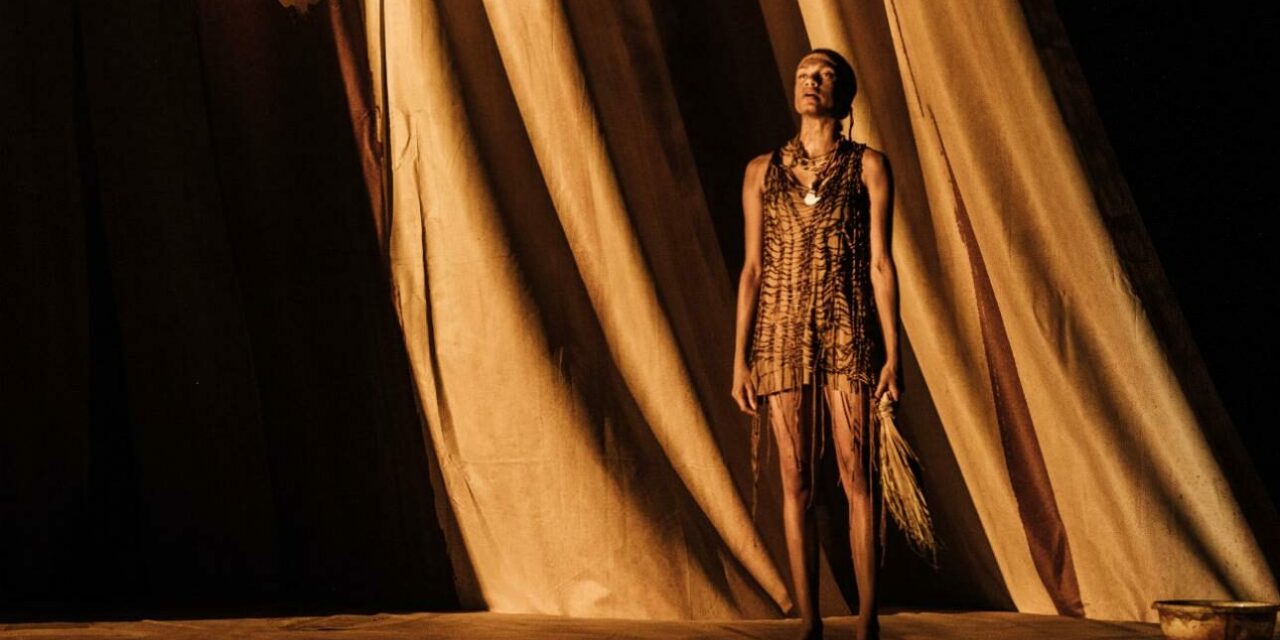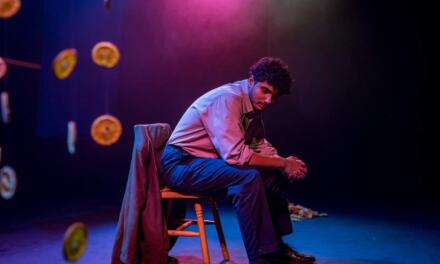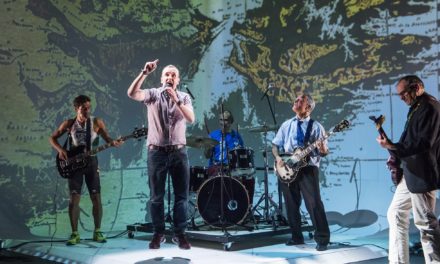The Sydney Theatre Company’s 2013 landmark staging of The Secret River to the United Kingdom was long overdue a tour. It is a significant production urging not only to understand traumatic events in our past and their consequences for the present but also drawing attention to their complexity. The show is the adaptation of Kate Grenville’s successful 2005 novel of the same name, which (inspired by the story of her great-great-great-grandfather) explores the history of Australia’s colonial past. It tells the life of a struggling Thames bargeman, William Thornhill, sent to a penal colony in New South Wales in 1806, reshaping his fate under new circumstances in Australia, at a price that he initially did not consider.
Grenville’s book, meticulously researched and written in a beautiful, poetic language, is full of humanism and empathy. (The novel was shortlisted for the Man Booker Prize, and won the Commonwealth Writers’ Prize, and the NSW Premier’s Literary Award.) It explores the story from the point of view of the protagonist, an ordinary working-class man, brought up in dire poverty in South London, trying to create a stable life for himself and his family. Thornhill is illiterate, hardworking, and good at heart. He is driven by his ambition and the love and responsibility he feels towards his family. As a result of a fatal mistake, he ends up in a penal colony in New South Wales, accompanied by his wife and two children. Later, when Thornhill gains a pardon, he discovers that instead of trying to go back to England, he could have a different life in New South Wales, by claiming a piece of land of his own. However, that land belongs to another, Indigenous family…
What is compelling and disturbing about Grenville’s novel is the way that she tells the story from the point of view of a settler, who is not an evil person, only an ordinary lad, ostracized from society for stealing, trying to provide for and protect his family. In many ways, his life is not dissimilar from those people whose land he will claim and whose dispossession he will contribute to. The reason it is uncomfortable to read Grenville’s novel is because, whilst Thornhill gains our sympathy, it is an increasingly uneasy position to hold, when, the reader is presented with a larger perspective that Thornhill does not fully understand, ignores or decides to put out of his mind, and even plays a part in. He is a victim of, as well as an agent for British colonialization, and this complexity makes the novel so powerful.
Andrew Bovell’s adaptation starts the story from the middle of the novel, from the turning point when Thornhill receives a pardon and decides to occupy a stretch of land he had seen on the Hawkesbury River. Bovell skillfully feeds the backstory into the play as and when necessary as he unfolds the story of the Thornhills building their new home on land that belongs to a family from the Dharug people.
Bovell’s adaptation’s merit is that it shifts the perspective, and gives name and voice to the Indigenous people who remained silent in the novel (whose actions Grenville chose to show from a distance, and interpret them only from the protagonist’s point of view), thus making the play the story and conflict of two families. Furthermore, with the help of Richard Green, who worked as a language consultant, a bilingual play was created (performed in English and Dharug languages), which emphasizes and renders more perceptible the difficulty and complexity of experiencing otherness, and the clash of two cultures. This (mis-)communication through, over, and between two languages becomes the highlight of the performance: contributing to many touching, painful, as well as humorous moments.
Whilst it is an enormous, unquestionable gain to have both sides’ of the story unfolded in the performance, it is at the loss of the strength and complexity of some of the English characters in the book. My biggest regret was to see the character and story of Thomas Blackwood (an English landowner with a more nuanced view of the Aboriginal peoples) fading into the background of extras. Similarly, Thornhill’s own son leaving his father and moving in with the seriously injured Blackwood as a protest against the massacre his father took part is less emphatic in the adaptation.
The mise-en-scène (director: Neil Armfield) is subtle, layered, and powerful. It takes the old-fashioned but reliable storytelling of the adaptation and renders it through an ‘empty stage’, metaphoric, poetic way of acting. The set is minimalistic, and the performance uses the power of storytelling, ensemble acting, and imagination to conjure up the world of the play. This directorial choice is thoroughly followed through with every component of the performance: the set and costumes, the lighting, the music, and even the make-up.
A subtly lit, curved, white silk curtain creates the impression of the enormous sandstone rocks of the landscape. The superb lighting (designed by Mark Howett) recreates the glow of the Australian sun. A flickering fireplace surrounded by logs of driftwood on the bare stage (set design by Stephen Curtis) constitutes the home of both the Dharug people and Thornhill’s family, as well as distilling the main theme of the play into one, powerful image.
The costumes, designed by Tess Schofield, subtly and respectfully signal the two different cultures’ attire without being naturalistic or ethnographic: warm, earth-colored garments, using simple knitted yarn or knotted leather or other natural yarns, often with fringes for the Dharug people, and a colder palette of distressed but once tailored workman’s attire: blazers, pinafore in shades of dark blues, browns, and greys for the English.
The non-naturalistic representation is further emphasized by the body painting all the characters have: the English wear white clay painting over their face, which makes their faces mask-like and adds a gothic, strangely alien quality to the characters. The Dharug people (played by Indigenous actors) have brown clay smudged on their bodies, making their representation on the stage one step removed.

“The Secret River” at the Edinburgh International Festival. Major ‘Moogy’ Sumner and Shaka Cook. Photo by Ryan Buchanan.
The story is narrated by a female character, Dhirrumbin, who represents the river (her name is the Dharug name for Hawkesbury River). The part was created for Ningali Lawford-Wolf, who was involved in the development of the performance from Grenville’s novel. The river as the narrator gives voice to the unspoken: the characters’ inner voice or feelings as well as retaining some of the beautiful lines from the original novel.
Unfortunately, during the play’s earlier run at the Edinburgh International Festival, Lawford-Wolf passed away. For the remainder of the tour, Pauline Whyman stepped in to play the role. Although, understandably, Whyman read her lines during the performance at the National Theatre in London, yet she managed to obtain a somber, dignified presence on the stage. When slowly proceeding on the stage in her long black, cape-like dress, she is more than a narrator but a force of nature, quietly witnessing the events.
The performance is supported throughout with very strong ensemble acting: a great orchestra of excellent actors attuned to each other and harmonizing together. Toby Challenor as William Thornhill and Georgia Adamson as Sal, his wife, displays a strong bond and determination. Jeremy Sims’ energy and physicality as the sinister Smasher Sullivan are powerful. Melissa Jaffer’s portrayal of Mrs. Herring as a tough survivor is excellent. Bruce Spence as the tragicomic Loveday is hilarious. The head of the Dharug family, Yalamundi, played by Major ‘Moogy’ Sumner AM, is dignified and commanding, but also subtly shows the ridiculous aspects of his communicational misunderstandings with Thornhill. These cultural negotiations are presented in several scenes in the play: between the men, between the children, and between the women. This is another powerful scene between Georgia Adamson, Dubs Yunupingu and Elma Kris when the women are exchanging food and household items with each other.
The storytelling in the first act feels a little slow sometimes, but the gentle humor and the music helps to re-energize scenes. The music (composed by Iain Grandage, and played live by the musical director Isaac Hayward and the performers themselves, on piano, double bass, guitar, and percussion) gives another, special dimension to the performance and further emphasizes this duality of cultures. It combines traditional English nursery rhymes and songs of the period (which evoke the memory of their former home in London), with traditional Dharug music and singing. The mélange is woven into an original composition that sometimes imitates the sounds of the landscape, is delicate and elaborate like a contemporary piece of classical music, at other times dynamic, and jazzy. In fact, the subtle soundscape and the beautiful, expressive music is a continuous, vital part of the fabric of the performance: telling through the language of music what words are inadequate to express. Such a moment, for instance, comes at the end of Act I, which closes with a song about home.
Centre stage the lights draw the shape of the house. ‘Inside’ Thornhill and his friends are sitting on chairs, celebrating the completion of his new dwelling with an emotional song about home, that also evokes their bittersweet memories of England. As the song develops and the harmonies become richer, the Dharug family appears, walking around Thornhill’s new home in a line, singing about homeland in their language. The two tunes harmonize and clash – expressing through the language of music the main conflict of the play: the place Thornhill claims as home is already someone else’s.
Another powerful scene is the massacre. Upstage, the Englishmen spread in a line, each of them holding an imaginary long gun, and clutching flour in their right fist (that is holding the imaginary gun’s trigger). With heavy steps they proceed downstage, whilst singing London Bridge is Falling Downin low, hoarse voices, gradually getting louder and louder. Every time they shoot, they blow into their right fist with the flour, which then makes a white cloud, as if a gun would have been fired. This metaphoric image carries several other semantic layers: it recalls the poisoned flour as well as the various infected items that the colonizers used to eliminate the Indigenous peoples. A history of calculated massacre summed up in a haunting image.

“The Secret River” at the Edinburgh International Festival. Georgia Adamson, Toby Challenor, Rory Potter and Nathanial Dean. Photo by Ryan Buchanan.
The end of the play is also disturbing, featuring another lasting image: whilst the last lines of the play are uttered by the only remainder of the Dharug family, Ngalamalum (played by Shaka Cook) claiming that this is their land, Thornhill is building a fence: with vigorous movements he is drawing line after line on the cloth at the back of the stage, marking up his territory. His movements, albeit larger and more determined, are not dissimilar from the marks Sal used to make on a tree trunk, counting the remaining days of their stay before they will return to London.
Apart from powerfully retelling a complex story from the colonial past, the Sydney Theatre Company’s performance raises profound questions about what we can do today about inherited conflicts that are impossible to simply resolve. How do we negotiate our lives in an “agitated symbiosis” (to borrow the term from contemporary Korean-American artist Anicka Yi), and how can it be possible to create from it a harmonic mélange.
Katalin Trencsényi was the 2019 Drama Creative Fellow of the University of Queensland.
This post was written by the author in their personal capacity.The opinions expressed in this article are the author’s own and do not reflect the view of The Theatre Times, their staff or collaborators.
This post was written by Katalin Trencsényi.
The views expressed here belong to the author and do not necessarily reflect our views and opinions.


















